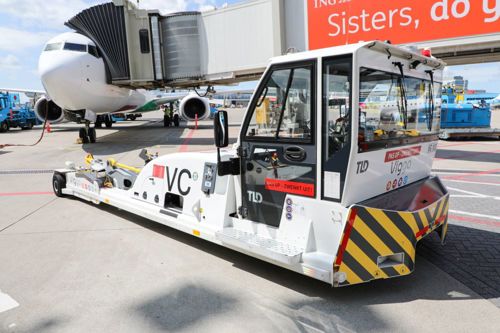
Picture credit: David Lee Photography for Phillips 66
Having been involved in Deutsche Post DHL Group’s GoGreen programme since 2008, Kathrin Brost, Vice President Global Head of GoGreen at DHL Global Forwarding has been able to observe how attitudes have changed over a long period of time.
She admits that it operated under the radar for a few years and when people were ordered to work from home during the pandemic, Brost was expecting a quiet life.
The opposite happened and she saw how people working in procurement, logistics and even CEOs were getting involved. Brost speculates that Covid may have made people realise how vulnerable supply chains are.
Extreme weather may have also played a part, with records constantly being broken and events such as flooding or wildfires occurring increasingly frequently with greater intensity.
Deutsche Post DHL Group has taken environmental concerns seriously for a long time, laying the foundations for the GoGreen programme in 2007 when the price of a barrel of crude oil hit $100, which coincided with the publication of numerous studies on CO2 and global warming. Brost says there was an increasing awareness combined with increased cost pressures.
Using 2007 as a baseline, the original target was to become 30% more carbon efficient by 2020 and the newly appointed CEO, Frank Appel, was a driving force behind the GoGreen programme.
Brost says, “Back then in 2008/2009, both within the company and on the customer side, there were still doubts whether climate change was a problem. I spent the first two to three years trying to convince people that we needed to act and that this is becoming increasingly important and we have a responsibility being one of the biggest logistics companies.”
The questions such as how to improve performance have stayed similar since around 2009/2010 but more people are asking them and requesting evidence that measures are being implemented.
The original target was met in 2016, four years ahead of schedule, around the time of the Paris Climate Agreement, so in 2017, DPDHL set the new target of Net Zero by 2050, making it the first logistics company to aim for Net Zero.
Brost comments, “Quite a few people said this is not realistic and we will never achieve it but this is what you need to do if you want to decarbonise in line with the Paris Agreement. We refined the target further, then in March 2021 we launched our new sustainability roadmap.”
Brost is proud that DPDHL Group developed a very detailed roadmap, setting science based targets for 2030 of halving its carbon footprint to below 29 million tonnes of CO2, which she says is important when compared to a business as usual scenario.
For 2030, decarbonisation is the focus across the different divisions of DPDHL Group by using the most efficient aircraft and ground vehicles, purchasing sustainable aviation fuel and upgrading facilities.
DHL Global Forwarding works closely with suppliers on measures such as sustainable fuel both in the aviation and maritime sectors.
Brost, “You have to push the market along, that is one of the key roles for us as a forwarder, our responsibility is to scale up demand; it is a chicken and egg situation because if there is no demand there is no supply. As a forwarder, we are a bit like a buyers’ club where we consolidate the demand of many customers so we are trying to push the demand and the supply for sustainable fuel solutions.”
When DHL Global Forwarding is talking to airline or container carrier partners, it has a evaluation scorecard to assess sustainability, the maturity of programmes and carbon efficiency for dialogue.
Sustainable fuels are an area of interest so DHL can reach its decarbonisation, with Brost expressing surprise that, having been so vocal about using 30% sustainable fuel by 2030, some airlines are only looking at 10%.
Brost says, “That is not good enough for us unless we buy large portions of their sustainable fuel. This is what we do, for example, last year DHL bought 18% of the available SAF on the market because we know that we need to meet our own decarbonisation targets but also because we feel that it is our role and responsibility to be a first mover to scale up the demand.”

Top level support
Sustainability has the full support of the Deutsche Post DHL Group board, with Brost highlighting the CFO getting heavily involved in developing internal carbon accounting when she was head of controlling.
Employees do not question the GoGreen programme or suggest that sustainability measures should be dropped.
Brost says explaining to employees how they can get engaged is key, so DPDHL developed the Certified GoGreen Specialist programme, which is a bit like a curriculum at university, where if you gain 30 credits, you become a specialist.
“Everyone, no matter to which business entity they belong, do foundation training, which is either classroom training or online where we speak about the importance to abate global warming and what is DPDHL trying to do,” says Brost.
Elective modules which are more functional specific explain the challenges in their business area and what the employees can do.
For board members and senior executives, ESG (environmental, social and governance) targets make up 30% of their total bonuses with each worth 10%. For this year, it has moved down to vice president level and is worth 10% of their bonuses.
In 2008, people were questioning the point but people have stopped asking questions and new employees are the ones asking DPDHL questions about its commitment to sustainability.
Brost says, “They choose companies which have a sustainability agenda. They would not work for a company without a sustainability focus.”
Scaling up production
Phillips 66 started producing sustainable fuels from used cooking oil at its Humber refinery in Immingham, Lincolnshire in 2017 and the decision to look at alternative uses of the fuel, such as in aviation was made during Covid.
Chris Gilbert, Manager – Humber Decarbonisation Project at Phillips 66 says while working with British Airways, it was decided to use kerosene type products and segregate it into SAF.
Audits, certification and confirmation of greenhouse gas savings took time but in early 2022, Phillips 66 started supplying British Airways with SAF.
Explaining why used cooking oil is a suitable fuel, Gilbert says, “It is a hydrocarbon molecule so a long chain molecule, and when you process it, the products it makes after some purifying and treating makes a drop in jet fuel. The chemical composition of used cooking oil behaves very similarly to the feedstocks that we use on the refinery in certain places.”
Phillips 66 has to make some changes in the refining process to accommodate to clean up some of the poisons and contaminants, the end product is the same as conventional fuel, so engines do not need to be modified.
Developing the product has been a journey, says Gilbert, going from the trial stage to managing issues and he promises investments in the years to come.
Potentially, there are other feedstocks such as used tyres, but the certification process is long and complex to make sure that there will be no safety issues.
Other companies are looking into tyres and other waste products such as municipal waste. In theory, they can be converted into kerosene, which would cut waste being sent to landfill but used cooking oil remains the best feedstock at present.
Fuel will make up a significant portion of the aviation industry’s goal of Net Zero by 2050, which means production will have to be scaled up.
Gilbert admits it will be challenging, saying, “We want to process more on the refinery but there are opportunities out there for other types of processing. It is a problem which we have to solve, a lot of people are talking about this, we are actually doing this at scale today and we are going to grow. We want to invest in the refinery to process more feedstock to make more SAF.”

Practical solutions
Amsterdam Airport Schiphol is committed to leading the way to a practical and sustainable future as airports aim to be climate neutral and zero waste by 2030 and the aviation sectors aims to be climate neutral by 2050, says Head of Cargo Joost van Doesburg.
To make operations sustainable, solutions available today need to be utilised, he says, such as using sustainable aviation fuel and decarbonising ground operations.
If and when electric- and hydrogen-powered aircraft are available, van Doesburg says these will be a gamechanger.
From the start of this year, HVO100, which emits 98% less CO2 than conventional diesel, has been used to fuel ground equipment. It is being used to run cars, delivery vans, pushback tractors and other vehicles.
Van Doesburg says, “We also offer airlines sustainable kerosene made from sustainable sources, renewable waste, and residual raw materials.”
Electric aviation is an area of interest with van Doesburg commenting, “The Royal Schiphol Group is committed to contributing to the development of electric planes by trialling models at our cargo hubs, and supporting initiatives such as the Power Up start-up that is studying the feasibility of flying on electricity and looking at the possibility of a network between various regions in Europe.”
For aviation and all industries, sustainability is no longer an option or an isolated policy, says van Doesburg, it is a top priority when developing business plans and projects.
Industries often face accusations of greenwashing so must prove that they are serious about sustainability through action.
Van Doesburg says, “The cargo industry is at a critical point in time where we can no longer just talk, we have to act, and act quickly. We will prove critics wrong by cutting down on carbon and reaching our targets through prioritisation and innovation.”
By 2050, Schiphol aims to be a circular and energy positive airport run entirely on sustainable solar, wind and thermal energy.
Van Doesburg says, “Not only are we determined to achieve this, but we are also setting ourselves the target of generating even more energy than we use, meaning the surplus will go to other consumers. This is an ambitious goal, but we are committed to making it a reality.”
This article was published in the August issue of Air Logistics International, click here to read the digital edition and click here to subscribe.
